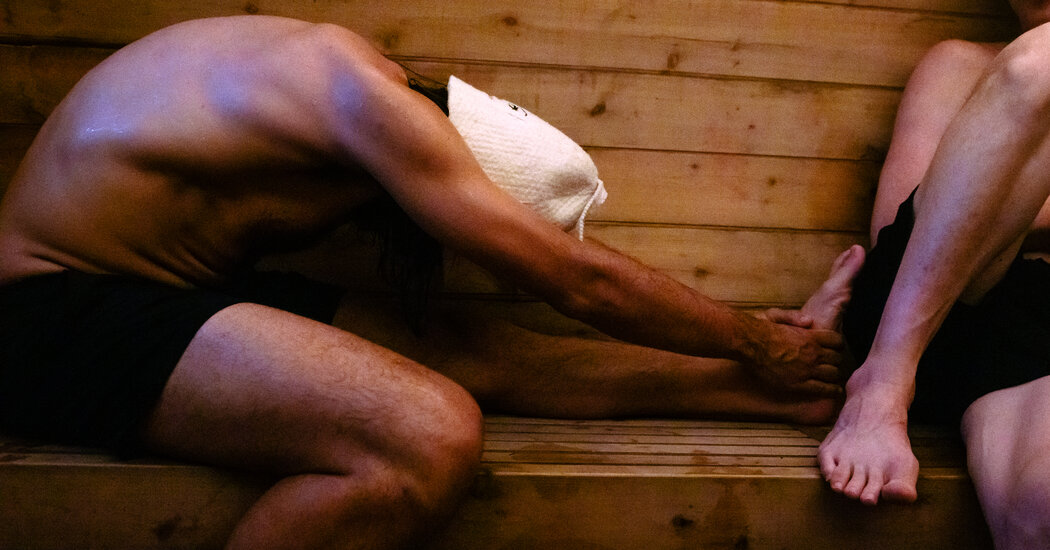After a hard workout, soaking in a hot tub or sitting in a steam room can be transcendent. A heating pad pressed on a particularly tight area of your lower back can help it feel looser after a long day of lifting boxes or hunching at your computer.
“I go to the sauna myself,” said Dr. Wen Chen, a program director at the National Center for Complementary and Integrative Health. After a long day of skiing over the holidays, her back tends to get sore, “but after sitting in the sauna, I’m cured for a couple of days,” she said.
But is it actually speeding up recovery, or does it just feel good?
The answer, it turns out, is yes. How heat interacts with sore muscles is still largely mysterious, but there are a few things that scientists can say. For one, it does ease pain. According to the American College of Physicians, using a heat wrap reduces pain more than a placebo and potentially even more than medications like Advil or Tylenol.
But what are the best kinds of heat? Is a hot bath better than a heating pad? How long after exercise is it most effective? Here’s what researchers know about what happens when heat gets under your skin.
Why does heat feel so good on sore muscles?
When you warm up a portion of your body with, say, a heating pad, your blood vessels relax, increasing blood flow to the area. With that increased blood flow come more oxygen and nutrients that can help heal your tissue, said Dr. Amy West, a rehabilitation specialist at NorthWell Health, a health care network in the New York area.
Heat also leads to chemical changes, such as lowering levels of cortisol in the blood.
Dr. Setor Kunotsor, an epidemiologist at the University of Leicester who has studied the effects of Finnish saunas, said that for people with musculoskeletal disorders like arthritis and fibromyalgia, saunas can lower pain by releasing endorphins, regulating your nervous system and reducing systemic inflammation.
What kind of heat is best?
There are many different ways to warm up your muscles: saunas, hot tubs, electric or chemical heating pads, wet towels, a cat that refuses to get off your chest. Which ones should you use and when?
Several small studies have suggested that heat coming from a wet source, like a hot water bottle or moist towel, can be more effective than dry heat for preventing pain and reducing muscle damage from exercise. One study, conducted on participants who did a series of squats designed to make their quadriceps sore, suggested that moist heat penetrates deeper into tissue faster and works more quickly than dry heat.
However, most studies in this area have focused on small heating sources, like heating pads or wraps. It’s not clear whether full-body heat immersion, like using a hot tub or sauna, has the same effect on muscles as localized heat applied directly to an area.
Theoretically, immersion should have a similar effect, Dr. Chen said, on a larger scale. Rather than simply increasing blood flow to a small area, a hot tub or sauna speeds up circulation throughout your body and directs blood flow away from your muscles and toward your skin.
But most of the relevant research has focused on how regular immersive heat, like a sauna several times a week, might improve health over time, rather than how a single session after a hard tennis game might make you feel.
What about temperature and timing?
To trigger many of the benefits of heat therapy, Dr. West said, “it has to be fairly hot to see some of these responses.”
Studies in animals have suggested that heat can have completely different effects depending on the exact temperature. Temperatures between 102.2 and 104 degrees Fahrenheit can increase inflammatory responses associated with pain. Temperatures over 105.8 can have the opposite effect, reducing inflammation and pain, explained Dr. Chen.
That’s pretty hot for whole-body heat immersion, said Dr. Chen, and most hot tubs are built to top out at 104 degrees to avoid heat stroke. Local heat is less likely to give you heat stroke than immersive heat, but you should still be careful that your water bottle or heating pad is not so hot that it can burn you (which can happen if your skin reaches about 110 degrees).
“That is something that actually happens more than you would think,” Dr. West said.
The best time to use heat on sore muscles seems to be immediately after exercise, and ideally for several hours. In a study in which participants wore out their leg muscles with squats, researchers compared the effects of using heat wraps right after exercising or 24 hours later. Muscles that were warmed immediately — for two hours with moist heat or eight hours with dry heat — experienced less damage and retained more strength than those heated later.
At the end of the day, there’s good reason to use heat on your muscles after a workout. “Physical therapists use a lot of heat,” said Dr. West. “Athletic trainers use a lot of heat.”
To give it a try on your own, she said, follow a few simple rules. First, pay attention to signs of dizziness that mean it’s time to get out of the sauna or hot tub. Second, don’t let a heating pad get so hot that you feel pain. Lastly, try to use it for several hours, but avoid falling asleep with it, because the longer you keep it on, the more likely your skin is to reach 110 degrees and burn.
Emma Yasinski is a freelance science journalist whose work has appeared in National Geographic, Undark and more.







